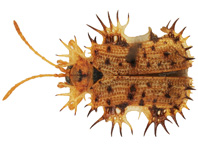Abstract
The Neotropical gecko genus Coleodactylus Parker 1926 was, until recently, composed of five species: C. amazonicus (Andersson 1918), C. brachystoma (Amaral 1935), C. meridionalis (Boulenger 1888), C. natalensis Freire 1999, and C. septentrionalis Vanzolini 1980 (Geurgas et al. 2008). However, several phylogenetic analyses recovered a polyphyletic Coleodactylus (Geurgas et al. 2008; Gamble et al. 2011a) leading Gamble et al. (2011b) to recognize a new genus, Chatogekko, for C. amazonicus. Coleodactylus and Chatogekko differ in both morphological and molecular characters. Coleodactylus has smooth dorsal scales and five scales forming the ungual sheath, while Chatogekko has keeled dorsal scales and four scales forming the ungual sheath (Gamble et al. 2011b). Furthermore, all Coleodactylus species have two deletions in the protein coding recombination-activating gene 1 (RAG1), one of six base pairs (bp) and another of 18 bp (Gamble et al. 2008a; Geurgas et al. 2008), while Chatogekko has a unique three bp deletion in the RBMX gene and a three bp deletion in the protein tyrosine phosphatase nonreceptor type 12 gene (PTPN12) (Gamble et al. 2011b). In addition, Chatogekko is differentiated from all others geckos by a unique set of 10 craniofacial features (Gamble et al. 2011b).
References
Agarwal, I. & Karanth, K.P. (2015) A phylogeny of the only ground-dwelling radiation of Cyrtodactylus (Squamata, Gekkonidae): diversification of Geckoella across peninsular India and Sri Lanka. Molecular Phylogenetics and Evolution, 82, 193–199.
http://dx.doi.org/10.1016/j.ympev.2014.09.016
Amaral, A. (1935) Collecta herpetologica no centro do Brasil. Memórias do Instituto Butantan, 9, 235–246.
Andersson, L.G. (1918) New lizards from South America, collected by Nils Holmgren and A. Roman. Arkiv för Zoologi, 16, 1–9.
Boulenger, G.A. (1888) On some reptiles and batrachians from Iguarasse, Pernambuco. Annals and Magazine of Natural History, 2, 40–43.
http://dx.doi.org/10.1080/00222938809460873
Freire, E.M.X. (1999) Espécie nova de Coleodactylus Parker, 1926 das dunas de Natal, Rio Grande do Norte, Brasil, com notas sobre suas relações e dicromatismo sexual no gênero (Squamata, Gekkonidae). Boletim do Museu Nacional, Nova Série, Zoologia, 399, 1–14.
Gamble, T., Bauer, A.M., Colli, G.R., Greenbaum, E., Jackman, T.R., Vitt, L.J. & Simons, A.M. (2011a) Coming to America: Multiple origins of New World geckos. Journal of Evolutionary Biology, 24, 231–244.
http://dx.doi.org//10.1111/j.1420-9101.2010.02184.x
Gamble, T., Bauer, A.M., Greenbaum, E. & Jackman, T.R. (2008a) Evidence for Gondwanan vicariance in an ancient clade of gecko lizards. Journal of Biogeography, 35, 88–104.
http://dx.doi.org//10.1111/j.1365-2699.2007.01770.x
Gamble, T., Bauer, A.M., Greenbaum, E. & Jackman, T.R. (2008b) Out of the blue: A novel, trans-Atlantic clade of geckos (Gekkota, Squamata). Zoologica Scripta, 37 (4), 355–366.
http://dx.doi.org/10.1111/j.1463-6409.2008.00330.x
Gamble, T., Colli, G.R., Rodrigues, M.T., Werneck, F.P. & Simons, A.M. (2012a) Phylogeny and cryptic diversity in geckos (Phyllopezus; Phyllodactylidae; Gekkota) from South America’s open biomes. Molecular Phylogenetics and Evolution, 62 (3), 943–953.
http://dx.doi.org/10.1016/j.ympev.2011.11.033
Gamble, T., Daza, J.D., Colli, G.R., Vitt, L.J. & Bauer, A.M. (2011b) A new genus of miniaturized and pug-nosed gecko from South America (Sphaerodactylidae: Gekkota). Zoological Journal of the Linnean Society, 163 (4), 1244–1266.
http://dx.doi.org/10.1111/j.1096-3642.2011.00741.x
Gamble, T., Greenbaum, E., Jackman, T.R. & Bauer, A.M. (2015) Into the light: Diurnality has evolved multiple times in geckos. Biological Journal of the Linnean Society, 115, 896–910.
http://dx.doi.org/10.1111/bij.12536
Gamble, T., Greenbaum, E., Jackman, T.R., Russell, A.P. & Bauer, A.M. (2012b) Repeated origin and loss of adhesive toepads in geckos. PLoS ONE, 7 (6), e39429.
http://dx.doi.org/10.1371/journal.pone.0039429
Geurgas, S.R., Rodrigues, M.T. & Moritz, C. (2008) The genus Coleodactylus (Sphaerodactylinae, Gekkota) revisited: A molecular phylogenetic perspective. Molecular Phylogenetics and Evolution, 49 (1), 92–101.
http://dx.doi.org/10.1016/j.ympev.2008.05.043
Gonçalves, U., Torquato, S.S., Skuk, G. & Sena, G.D.A. (2012) A new species of Coleodactylus Parker, 1926 (Squamata: Sphaerodactylidae) from the Atlantic Forest of northeast Brazil. Zootaxa, 3204, 20–30.
Hall, T.A. (1999) BIOEDIT: a user-friendly biological sequence alignment editor and analysis program for Windows 95/98/NT. Nucleic Acids Symposium Series, 41, 95–98.
Ronquist, F. & Huelsenbeck, J.P. (2003) Mrbayes 3: Bayesian phylogenetic inference under mixed models. Bioinformatics, 19, 1572–1574.
http://dx.doi.org/10.1093/bioinformatics/btg180
Larkin, M.A., Blackshields, G., Brown, N.P., Chenna, R., McGettigan, P.A., McWilliam, H., Valentin, F., Wallace, I.M., Wilm, A., Lopez, R., Thompson, J.D., Gibson, T.J. & Higgins, D.G. (2007) ClustalW and ClustalX version 2. Bioinformatics, 23, 2947–2948.
http://dx.doi.org/10.1093/bioinformatics/btm404
Makhubo, B.G., Tolley, K.A. & Bates, M.F. (2015) Molecular phylogeny of the Afroedura nivaria (Reptilia: Gekkonidae) species complex in South Africa provides insight on cryptic speciation. Molecular Phylogenetics and Evolution, 82, 31–42.
http://dx.doi.org/10.1016/j.ympev.2014.09.025
Miller, M.A., Pfeiffer, W. & Schwartz, T. (2010) Creating the CIPRES Science Gateway for inference of large phylogenetic trees. Proceedings of the Gateway Computing Environments Workshop, New Orleans, LA, 8 pp.
Parker, H.W. (1926) The Neotropical lizards of the genera Lepidoblepharis, Pseudogonatodes, Lathrogecko, and Sphaerodactylus, with the description of a new genus. Annals and Magazine of Natural History, 17, 291–301.
http://dx.doi.org/10.1080/00222932608633413
Posada, D. (2008) jModelTest: phylogenetic model averaging. Molecular Biology and Evolution, 25 (7), 1253–1256.
http://dx.doi.org/10.1093/molbev/msn083
Rambaut, A., Suchard, M.A., Xie, D. & Drummond, A.J. (2014) Tracer v1.6. Available from: http://beast.bio.ed.ac.uk/Tracer (accessed 13 November 2015)
Sambrook, J., Fritsch, E.F. & Maniatis, T. (1989) Molecular Cloning: A Laboratory Manual. Cold Spring Harbor Laboratory Press, New York, 1626 pp.
Shimodaira, H. (2002) An approximately unbiased test of phylogenetic tree selection. Systematic Biology, 51 (3), 492–508.
http://dx.doi.org/10.1080/10635150290069913
Shimodaira, H. & Hasegawa, M. (1999) Multiple comparisons of log-likelihood with applications to phylogenetic inference. Molecular Biology and Evolution, 16, 1114–1116.
Stamatakis, A. (2014) RAxML Version 8: A tool for phylogenetic analysis and post-analysis of large phylogenies. Bioinformatics, 30 (9), 1312–1313.
http://dx.doi.org/10.1093/bioinformatics/btu033
Swofford, D.L. (2003) PAUP*. Phylogenetic Analysis Using Parsimony (*and Other Methods). Version 4. Sinauer Associates, Sunderland, Massachusetts.
Townsend, T.M., Larson, A., Louis, E. & Macey, J.R. (2004) Molecular phylogenetics of Squamata: the position of snakes, amphisbaenians, and dibamids, and the root of the squamate tree. Systematic Biology, 53 (5), 735–757.
http://dx.doi.org/10.1080/10635150490522340
Vanzolini, P.E. (1980) Coleodactylus septentrionalis, sp. n., with notes on distribution of the genus (Sauria, Gekkonidae). Papéis Avulsos de Zoologia, 34, 1–9.

